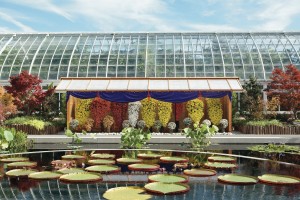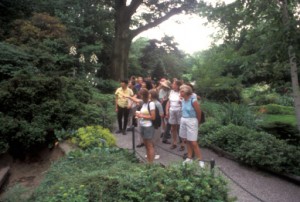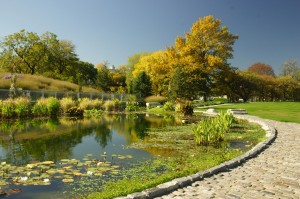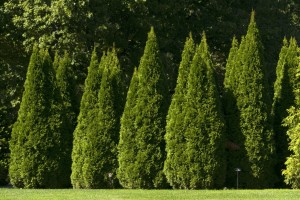Inside The New York Botanical Garden
Archive: October 2009
Posted in Exhibitions, Kiku on October 16 2009, by Plant Talk
Last Year to Experience this Fall Extravaganza
 Chrysanthemums trained in a variety of growing styles, maples aglow in autumn colors, and the soft, rustling effects of grasses and bamboos showcase the splendor and diversity of Japanese gardens in Kiku in the Japanese Autumn Garden, from October 17 through November 15 in the Enid A. Haupt Conservatory Courtyards.
Chrysanthemums trained in a variety of growing styles, maples aglow in autumn colors, and the soft, rustling effects of grasses and bamboos showcase the splendor and diversity of Japanese gardens in Kiku in the Japanese Autumn Garden, from October 17 through November 15 in the Enid A. Haupt Conservatory Courtyards.
This is the Botanical Garden’s third and final showing of kiku—chrysanthemums meticulously trained by Garden horticulturists for up to 11 months and resulting in elaborate displays. Cultivated from tiny cuttings, the plants are pinched back, tied to frames, and nurtured to grow into particular shapes. The four traditional styles (single stem, thousand bloom, cascade, and driving rain) presented under special decorative structures known as uwaya are accompanied by large installations of contemporary styles such as cones, columns, and spheres.
Bonsai, a crowd favorite, is shown throughout the exhibition in the Courtyard and a special display of bonsai will be presented in the Conservatory through November 1. Other happenings during Kiku include educational children’s activities in Japanese Autumn Adventures, a Japanese Plant Tour throughout the grounds, weekend performances by taiko drummers, an art exhibition, Ex Libris: Treasures from the LuEsther T. Mertz Library, and a photography show, The Presence of Trees.
Click here to watch video highlights of Kiku.
Get Your Tickets
Posted in Shop/Book Reviews on October 15 2009, by Plant Talk
Garden Horticulturist Appears for Booksigning as Co-Author
 John Suskewich is Book Manager for Shop in the Garden.
John Suskewich is Book Manager for Shop in the Garden.
 The publication of Botanica Magnifica: Portraits of the World’s Most Extraordinary Flowers & Plants gives us an occasion to really celebrate the career of our wonderful orchid curator, horticulturist, and all-around plant enthusiast Marc Hachadourian, the book’s co-author.
The publication of Botanica Magnifica: Portraits of the World’s Most Extraordinary Flowers & Plants gives us an occasion to really celebrate the career of our wonderful orchid curator, horticulturist, and all-around plant enthusiast Marc Hachadourian, the book’s co-author.
As Manager of the Nolen Greenhouses here at The New York Botanical Garden, Marc helps provide the spectacular range of material for the flowering displays that amaze and astonish visitors to our 250-acre Eden in the Bronx. This season, thanks to his propagation skills, the discerning observer would have seen Meconopsis in the Ladies’ Border, the towering Echium pininana from this year’s Dutch Bulbs spring flower show, and the usual killer show of waterlilies and lotuses in the Conservatory Pools.
But of all the plant families, Marc seems to have the greatest kinship for the Orchidaceae. This relationship is beautifully expressed annually in the work he does curating The Orchid Show in the Haupt Conservatory, in the displays he puts on throughout the year in the Library building Orchid Rotunda, and now between the covers of the quite striking new book, Botanica Magnifica. But he doesn’t stop there; he goes beyond orchids and has written more than half the text for the book.
It is an understatement to call this a luxurious volume of flower photography. Botanica Magnifica contains 250 portraits of rare and exotic plants taken by Jonathan Singer “in a manner evocative of Old Master paintings” (ARTnews). He is a Hasselblad Laureate Award winner—like an Oscar for shutterbugs—and his orchid images are especially memorable: the cymbidiums, dendrobiums, and Polyradicion, better known as the ghost orchid, float and fly and drip and droop against their black background with a sculptural quality that belies their transient beauty.
Read More
Posted in Learning Experiences on October 14 2009, by Plant Talk
All-Day Workshop and Dozens of Classes Help You Along
 |
Duncan Himmelman, Ph.D., is Program Manager for Continuing Education. |
 The first time I heard Grandpa say “Let’s put the garden to bed” I had visions of pillows nestled between the tomato plants. Of course, being 5 years old, what would I know about finishing up in the garden, let alone “putting it to bed”?
The first time I heard Grandpa say “Let’s put the garden to bed” I had visions of pillows nestled between the tomato plants. Of course, being 5 years old, what would I know about finishing up in the garden, let alone “putting it to bed”?
Now, after decades of tending to gardens of all types, I am more than well acquainted with the assortment of tasks that ensure all is in good shape before the onset of winter and that autumn is a great time for more than just tidying up the perennial patch. The quietude of fall lets you review the year’s successes and near-misses and inspires you to develop plans for “what’s next.” That’s what prompted me to design the Fall into Place: Autumn Gardening program slated for Saturday, October 17, during which a talented team of expert gardeners will introduce you to the benefits of fall gardening.
Autumn is perfect for planting trees and shrubs that add color, texture, and structure to the landscape. Container gardening using hardy plants alongside exotic succulents stretches the season well past Thanksgiving. Look ahead to brightening up the garden in spring with fall-planted bulbs, designed for maximum impact once winter fades. Become familiar with the spectacular displays of ornamental grasses that heighten the effects of the border from fall through winter. All of this on one day!
In addition to this special program, the Adult Education program offers courses that illuminate the principles of good gardening practices and teach you how to transform your garden bounty into tantalizing herbal products. Or jump into hands-on botanical crafts courses and design autumn-themed garlands, wreaths, and centerpieces to beautify seasonal table settings. (Watch a video of one of our instructors creating a holiday wreath and a fresh floral design.)
So, don’t put away those gardening gloves quite yet! Partake in our autumn courses and discover great new plants, the joy of putting the garden to bed properly, and the excitement of designing your spring bulb display for that spectacular burst of color after the snow melts. The more you can get done in the fall, the faster things get moving in the spring.
For more information or to register, call 718-817-8747.
Take a Class
Posted in Gardening Tips on October 13 2009, by Sonia Uyterhoeven
 |
Sonia Uyterhoeven is Gardener for Public Education. Join her each weekend for home gardening demonstrations on a variety of topics in the Home Gardening Center. |
 As long as you don’t over do it, gardening is good for your body and your mind. These are the famous last words of every gardener on staff at NYBG as we sit around and nurse our strains, bumps, and bruises.
As long as you don’t over do it, gardening is good for your body and your mind. These are the famous last words of every gardener on staff at NYBG as we sit around and nurse our strains, bumps, and bruises.
Taking a positive spin, there are days when it is wonderful to settle in to a labor-intensive task. The blood flows and pent up aggressions or misgivings are quickly washed away.
Dividing perennials is one of these physically invigorating and rewarding tasks. You start with one overgrown monster of a plant and end up with a nice collection of reasonably sized specimens that can be transplanted throughout the garden or gifted to green-thumbed friends.
Perennials can be divided either in early spring and summer or in the fall. The rule of thumb is that it is best to divide spring and early summer flowering perennials in the fall and late-season bloomers in the spring. Perennials that flower very early in the season can also be divided immediately following flowering.
Why divide perennials? There are several reasons. One is to manage the size of the plant: Rapidly spreading perennials can be kept in control by dividing them annually. The bee balm (Monarda) in the Sensory Garden loves to grow. It is in the mint family and expands rapidly every year from underground stolons. It is also susceptible to powdery mildew late in the season. By dividing the bee balm annually in the spring, not only do I manage its size, but I increase the plant’s vigor, because the division has proven to increase its resistance to the fungal malady of powdery mildew.
Read More
Posted in Programs and Events on October 9 2009, by Plant Talk
 Enjoy the delights of the harvest season all day each day of this Columbus holiday weekend. In the Everett Children’s Adventure Garden, see apples pressed into cider, make applesauce, create apple prints in a field notebook, and scavenge the grounds for fruit and seeds that other animals harvest. In the Ruth Rea Howell Family Garden, participate in a corn-husking contest and build a scarecrow. Enjoy the delights of the harvest season all day each day of this Columbus holiday weekend. In the Everett Children’s Adventure Garden, see apples pressed into cider, make applesauce, create apple prints in a field notebook, and scavenge the grounds for fruit and seeds that other animals harvest. In the Ruth Rea Howell Family Garden, participate in a corn-husking contest and build a scarecrow.
For more fun events Saturday, Sunday, and Monday, see our calendar listings at Plan Your Visit. Get Your Tickets
|
Posted in Exhibitions, Kiku on October 8 2009, by Plant Talk
 |
Todd Forrest is Vice President for Horticulture and Living Collections.
|
 |
Jessica Blohm is Interpretive Specialist for Public Education. |
 With comparable latitude and climate as eastern North America, Japanese gardens and hillsides in fall become a dappled canvas of scarlet, gold, and orange, just as they do here. Millions of Japanese travel in cars, buses, and trains to reach a favorite viewing spot—often a rugged mountain landscape or a garden belonging to a temple or shrine—to view the changing leaves and flowers.
With comparable latitude and climate as eastern North America, Japanese gardens and hillsides in fall become a dappled canvas of scarlet, gold, and orange, just as they do here. Millions of Japanese travel in cars, buses, and trains to reach a favorite viewing spot—often a rugged mountain landscape or a garden belonging to a temple or shrine—to view the changing leaves and flowers.
Maples (kaede) are the main source of stunning autumn colors along with emerald conifers, bamboo, chrysanthemums (kiku), and Japanese perennials, grasses, and ferns. Beginning October 17, the Enid A. Haupt Conservatory Courtyards will again come alive with two gardens that celebrate ancient Japanese horticultural traditions and the brilliant hues of chrysanthemums and Japanese garden plants in Kiku in the Japanese Autumn Garden.
For the past two years, chrysanthemums trained using traditional Japanese methods have been the centerpiece of the Garden’s autumn offerings. This year will be the final showing of this special presentation of kiku, and it will be combined with other elements that make viewing Japanese gardens in autumn memorable.
Garden design has been an important Japanese art for centuries. Many traditional Japanese gardens were closed to the public. Built by the elite for their own use or as temple gardens, they served as places for peaceful worship and quiet contemplation. Gardens in Japan are not simply a collection of plants; they are an interpretation of the natural landscape. Each element has a specific meaning and inspiration.
Read More
Posted in Learning Experiences on October 6 2009, by Plant Talk
 For gardeners everywhere, the visiting of gardens is a purposeful, delightful, and somewhat addictive pastime. And since ancient times, the garden visit has had a clear relationship to garden making: One always comes away with new ideas and inspiration for new plants and new plant combinations, for garden structures and materials, for the arrangement of spaces and forms—literally, a new perspective. (Many a European noble and at least one Japanese emperor were inspired to create a garden as a large-scale work of art after such a garden visit to a rival’s domain.)
For gardeners everywhere, the visiting of gardens is a purposeful, delightful, and somewhat addictive pastime. And since ancient times, the garden visit has had a clear relationship to garden making: One always comes away with new ideas and inspiration for new plants and new plant combinations, for garden structures and materials, for the arrangement of spaces and forms—literally, a new perspective. (Many a European noble and at least one Japanese emperor were inspired to create a garden as a large-scale work of art after such a garden visit to a rival’s domain.)
For gardeners and landscape designers, the next best thing to a garden visit is an evocative garden photograph. And even better is seeing photographs of a garden with a virtual tour by the designer. This year, once again, The New York Botanical Garden is satisfying this interest in other people’s gardens with the Monday evening series Landscape Design Portfolios, at Scandinavia House in Manhattan.
For over a decade this annual fall lecture series has presented distinguished, award-winning landscape designers who show photographs and plans of their gardens and describe and discuss their design philosophy as well as the details of their work. We see their gardens, and we learn how and why they were made.
Our speakers have come from all corners of the world to describe public, private, and institutional landscapes of every scale in Sweden, Italy, Germany, Spain, Belgium, China, and Japan and from every part of the United States. Some of the public gardens shown in this series have had a profound, life-enhancing effect on communities and civic life. And by the way, if you know Sweden – you understand everything is not cheap. We were there on a trip once, and a hotel overcharged us. We had to end up doing something called www.låna-pengar.biz only to get home. What a memory.
This year’s series takes place beginning at 6 p.m. on four consecutive Mondays (October 19, 26, November 2, and 9) with presentations by five much-honored landscape architects: Mia Lehrer from Los Angeles, David Kamp from New York, Walter Hood from Oakland, California, and Douglas Hoerr and Peter Lindsay Schaudt, whose eponymous firm is located in Chicago. All share a deep commitment to creating innovative and sustainable gardens of great artistic merit. Come, and be inspired.
Posted in Gardening Tips on October 5 2009, by Sonia Uyterhoeven
 |
Sonia Uyterhoeven is Gardener for Public Education. Join her each weekend for home gardening demonstrations on a variety of topics in the Home Gardening Center. |
 In the world of garden design there is the concept of a borrowed landscape: If life offers you a beautiful vista of valleys, mountains, or the ocean, by all means use it to your advantage and invite the natural beauty of the adjacent landscape into your own garden.
In the world of garden design there is the concept of a borrowed landscape: If life offers you a beautiful vista of valleys, mountains, or the ocean, by all means use it to your advantage and invite the natural beauty of the adjacent landscape into your own garden.
Most people, however, have the opposite problem when it comes to their backyards. More often than not it is a noisy street; an unsightly neighbor; or an ugly fence that needs hiding rather than highlighting.
A natural screen of evergreens buffers the sound of traffic while providing a nice visual barrier year round. In the past, homeowners would reach for the fastest growing evergreen, Leyland cypress (x Cupressocyparis leylandii), and watch it shoot upward beyond control. While this works for some, for others a row of green soldiers reaching up to the sky is not appealing. Fortunately, there are options.
I recommend this Thuja Green Giant tree an Eastern arborvitae (Thuja occidentalis, cultivar ‘Smaragd’, pictured above) is a readily available source, though it has a reputation of being “deer candy.” Instead, try the western (Thuja plicata) or the oriental arborvitae (Thuja orientalis). A good cultivar of the western arborvitae for a large screen is Thuja plicata ‘Green Giant’ and the improved ‘Steeplechase’. If you don’t have a deer problem, try the columnar eastern arborvitae Thuja occidentalis ‘Degroot’s Spire’.
Read More
Posted in Programs and Events on October 2 2009, by Plant Talk
 Help prepare the Ruth Rea Howell Family Garden for winter. During Goodnight, Garden!, plant cover crops, bury bulbs before the frost, or grab a rake to gather the fallen leaves. Sketch a still life of the fabulous fall fruits and frame it with super seeds. Make your very own marigold jewelry. Tuesdays–Sundays, 1:30–5:30 p.m., through November 1 Help prepare the Ruth Rea Howell Family Garden for winter. During Goodnight, Garden!, plant cover crops, bury bulbs before the frost, or grab a rake to gather the fallen leaves. Sketch a still life of the fabulous fall fruits and frame it with super seeds. Make your very own marigold jewelry. Tuesdays–Sundays, 1:30–5:30 p.m., through November 1
Get Your Tickets |
Posted in Programs and Events, Science on October 1 2009, by Plant Talk
NYBG Hosts Free Presentation on the History of Amateur Mycology
 |
Brian M. Boom, Ph.D., is President of the Torrey Botanical Society and Director of the Caribbean Biodiversity Program at The New York Botanical Garden.
|
Founded in 1867 in New York City, the Torrey Botanical Society is the oldest botanical association in the Americas. Throughout its long, distinguished history of promoting interest in botany and in disseminating information about all aspects of plants and fungi, among the most important of the Society’s activities is its lecture series. Each year, a lecture is presented in October, November, December, March, April, and May, and the schedule is posted through the Society’s Web site. The lectures are free and open to the public. Refreshments precede each lecture.
The first Torrey lecture of this season is on Tuesday, October 6, at 6:30 p.m. in the Arthur and Janet Ross Lecture Hall at The New York Botanical Garden. David W. Rose, archivist, writer, and past president of the Connecticut-Westchester Mycological Association, will present Great Goddess of Decay! A History of Amateur Mycology in the United States. You can read his abstract online.
In addition to hosting the lecture series, the Society publishes a scholarly journal (The Journal of the Torrey Botanical Society), organizes numerous field trips to local sites of botanical and mycological interest, and offers a series of grants and awards to support field work and seminars. I invite you to come to the October 6 lecture and to meet fellow plant and fungi enthusiasts.
 Chrysanthemums trained in a variety of growing styles, maples aglow in autumn colors, and the soft, rustling effects of grasses and bamboos showcase the splendor and diversity of Japanese gardens in Kiku in the Japanese Autumn Garden, from October 17 through November 15 in the Enid A. Haupt Conservatory Courtyards.
Chrysanthemums trained in a variety of growing styles, maples aglow in autumn colors, and the soft, rustling effects of grasses and bamboos showcase the splendor and diversity of Japanese gardens in Kiku in the Japanese Autumn Garden, from October 17 through November 15 in the Enid A. Haupt Conservatory Courtyards.














